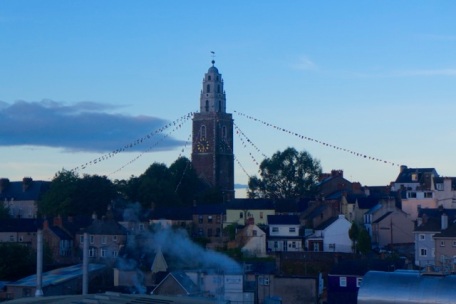Just as London has Big Ben, and Paris the Eiffel Tower, Cork has Shandon Church. This modest chapel, by no means the largest or most ornate church in Cork, is by far the most emblematic.
I found myself in Cork very early one morning last September. Having a few hours to waste before work, I headed towards St Anne’s Church in an attempt to understand its enigmatic hold over the city.
St Anne’s dates from 1722, its famous bells installed in 1750, it’s clock mechanism a hundred years later. The church is built of red sandstone and white limestone, which have come to represent the colours of Cork City and county. The clock faces, notoriously inaccurate, have given the church its nickname ‘The Four Faced Liar’*. The large gold-plated salmon, ‘de goldie fish’, on the top is a nod to Cork’s booming salmon industry of the time. Situated a short distance north of the River Lee and a stone’s throw from Cork’s North Cathedral, the narrow streets and alleys around it are a throwback to earlier times. The Butter Museum and the Firkin Crane theatre, Cork’s home of dance, rests in its shadow.
Because of its centrality, its central position and its idiosyncratic design, Shandon is the true heart of Cork City. While the city itself has gone through a transformation in the last few years, with glass and polished marble growing up where dowdy brick and concrete buildings once stood, this symbol of Cork’s heritage remains unchallenged.
* This is the name of a famous Irish pub in New York City, which in turn became the name of a 2010 award winning independent movie.














[…] of course not the case. It wasn’t before I got off the bus when I realized that I had arrived in Cork. It was late evening and I had accommodation booked in a hostel 200 km north from where I […]